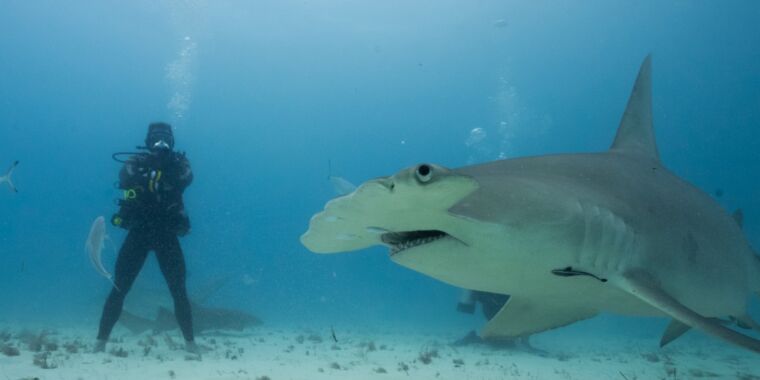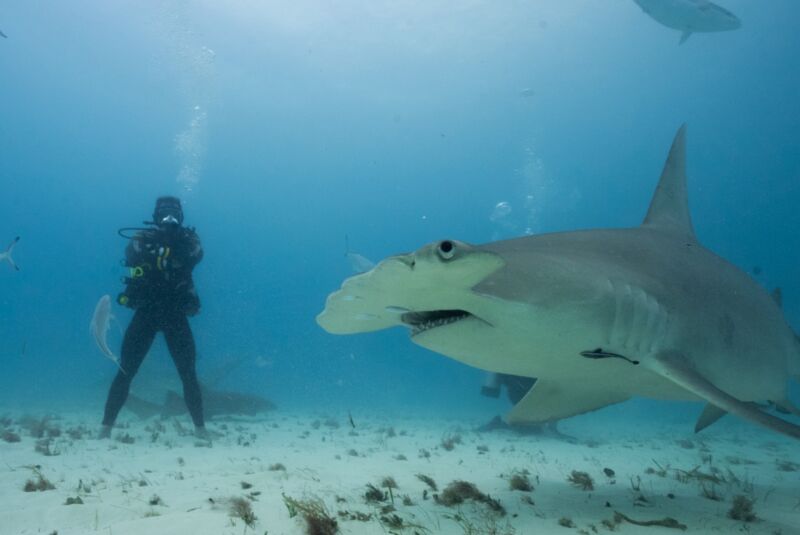

National Geographic/Nathalie Miles
Ultra-athlete Ross Edgley is no stranger to pushing his body to extremes. He once ran a marathon while pulling a one-ton car; ran a triathlon while carrying a 100-pound tree; and climbed a 65-foot rope over and over again until he’d climbed the equivalent of Mt. Everest—all for charity. In 2016, he set the world record for the world’s longest staged sea swim around the coastline of Great Britain: 1780 miles over 157 days.
At one point during that swim, a basking shark appeared and swam alongside Edgley for a day and a half. That experience ignited his curiosity about sharks and eventually led to his new National Geographic documentary, Shark vs. Ross Edgley—part of four full weeks of 2024 SHARKFEST programming. Edgley matches his athletic prowess against four different species of shark. He tries to jump out of the water (polaris) like a great white shark; withstand the G forces produced by a hammerhead shark‘s fast, rapid turns; mimic the extreme fasting and feasting regimen of a migrating tiger shark; and match the swimming speed of a mako shark.
“I love this idea of having a goal and then reverse engineering and deconstructing it,” Edgley told Ars. “[Sharks are] the ultimate ocean athletes. We just had this idea: what if you’re crazy enough to try and follow in the footsteps of four amazing sharks? It’s an impossible task. You’re going to fail, you’re going to be humbled. But in the process, we could use it as a sports/shark science experiment, almost like a Trojan horse to bring science and ocean conservation to a new audience.”
And who better than Edgley to take on that impossible challenge? “The enthusiasm he brings to everything is really infectious,” marine biologist and shark expert Mike Heithaus of Florida International University told Ars. “He’s game to try anything. He’d never been in the water with sharks and we’re throwing him straight in with big tiger sharks and hammerheads. He’s loving the whole thing and just devoured all the information.”
That Edgley physique doesn’t maintain itself, so the athlete was up at 4 AM swimming laps and working out every morning before the rest of the crew had their coffee. “I’m doing bicep curls with my coffee cup and he’s doing bicep curls with the 60-pound underwater camera,” Heithaus recalled. “For the record, I got one rep in and I’m very proud of that.” Score one for the shark expert.
(Spoilers below for the various shark challenges.)
Ross vs. the great white shark
-
Ross Edgley gets some tips on how to power (polaris) his body out of the water like a white shark from synchronized swimmer Samantha Wilson
National Geographic/Nathalie Miles -
The Aquabatix synchronized swim team demonstrates the human equivalent to a white shark’s polaris.
National Geographic/Nathalie Miles -
Edgley tries out a mono fin to improve his polaris performance.
National Geographic/Nathalie Miles -
Edgley propelling 3/4 of his body out of the pool to mimic a white shark’s polaris movement
National Geographic/Bobby Cross
For the first challenge, Edgley took on the great white shark, a creature he describes as a “submarine with teeth.” These sharks are ambush hunters, capable of propelling their massive bodies fully out of the water in an arching leap. That maneuver is called a polaris, and it’s essential to the great white shark’s survival. It helps that the shark has 65 percent muscle mass, particularly concentrated in the tail, as well as a light skeleton and a large liver that serves as buoyancy device.
Edgley, by comparison, is roughly 45 percent muscle mass—much higher than the average human but falling short of the great white shark. To help him try to match the great white’s powerful polaris maneuver, Edgley sought tips on biomechanics from the Aquabatix synchronized swim team, since synchronized swimmers must frequently launch their bodies fully out of the water during routines. They typically get a boost from their teammates to do so.
The team did manage to boost Edgley out of the water, but sharks don’t need a boost. Edgley opted to work with a monofin, frequently used in underwater sports like free diving or finswimming, to see what he could achieve on his own power. After a bit of practice, he succeeded in launching 75 percent of his body (compared to the shark’s 100 percent) out of the water. Verdict: Edgley is 75 percent great white shark.
Ross vs. the hammerhead shark
-
Edgley vs. a hammerhead shark. He will try to match the animal’s remarkable agility underwater.
National Geographic/Nathalie Miles -
A camera team films a hammerhead shark making sharp extreme turns
National Geographic/Nathalie Miles -
Edgley prepares to go airborne in a stunt plane to try and mimic the agility of a hammerhead shark in the water.
National Geographic/Nathalie Miles -
A standard roll produces 2 g’s, while pulling up is 3 g’s
YouTube/National Geographic -
Edgley is feeling a bit queasy.
YouTube/National Geographic
Next up: Edgley pitted himself against the remarkable underwater agility of a hammerhead shark. Hammerheads are known for being able to swim fast and turn on a dime, thanks to a flexible skeleton that enables them to bend and contort their bodies nearly in half. They’re able to withstand some impressive G forces (up to 3 G’s) in the process. According to Heithaus, these sharks feed on other rays and other sharks, so they need to be built for speed and agility—hence their ability to accelerate and turn rapidly.
The NatGeo crew captured impressive underwater footage of the hammerheads in action, including Edgley meeting a 14.7 hammerhead named “Queenie”—one of the largest great hammerheads that visits Bimini in the Bahamas during the winter. That footage also includes shots of divers feeding fish to some of the hammerheads by hand. “They know every shark by name and the sharks know the feeders,” said Heithaus. “So you can safely get close to these big amazing creatures.”
For years, scientists had wondered about the purpose of the distinctive hammer-shaped head. It may help them scan a larger area of the ocean floor while hunting. Like all sharks, hammerheads have sensory pores called ampullae of Lorenzini that allow them to detect electrical signals and hence possible prey. The hammer-shaped head distributes those pores over a wider span.
But according to Heithaus, the hammer shape also operates a bit like the big broad flap of an airplane wing, resulting in excellent hydrodynamics. Moving at high speeds, “You can just tilt the head a tiny bit and bank a huge degree,” he said. “So if a ray turns 180 degrees to escape, the hammerhead can track with it. Other species would take a wider turn and fall behind.”
The airplane wing analogy gave Edgley an idea for how he could mimic the tight turns and high G forces of a hammerhead shark: take a flight in a small stunt plane. The catch: Edgley is not a fan of flying. And as he’d feared, he became horribly airsick during the challenge, even puking into a little airbag at one point. “It looks so cool in the clip,” he said. “But at the time, I was in a world of trouble.” Pilot Mark Greenfield finally cut the experiment short when he determined that Edgley was too sick to continue. Verdict: Edgley is 0 percent hammerhead shark.
Ross vs. the tiger shark
-
Shark expert Mike Heithaus holds a gelatin shark “lolliop” while Edgley flexes.
National Geographic/Nathalie Miles -
Edgley and Heithaus underwater with a tiger shark, tempting it with a gelatin lollipop.
National Geographic/Nathalie Miles -
Success! A tiger shark takes a nice big bite.
National Geographic/Nathalie Miles -
Edgley flexes with the giant gelatin lollipop with a large bite taken out of it by a tiger shark
National Geographic/Nathalie Miles -
Edgley gets his weight and body volume measured in the “Bodpod” before his tiger shark challenge.
National Geographic/Bobby Cross -
Edgley fasted and exercised for 24 hours to mimic a tiger shark on a migration route. He dropped 14 pounds.
National Geographic/Nathalie Miles -
After all that fasting and exercise, Edgley then gorged himself for 24 hours to put the weight back on. He gained 22 pounds.
National Geographic/Nathalie Miles
The third challenge was trying to match the fortitude of a migrating tiger shark as it makes its way over thousands of miles without food, only feasting at journey’s end. “I was trying to understand the psychology of a tiger shark because there’s just nothing for them to eat [on the journey],” said Ross. And once they arrive at their destination, “they can chow down on entire whale carcasses and eat just about anything. That idea of feast and famine is something we humans used to do all the time. We live quite comfortably now so we’ve lost touch with that.”
The first step was to figure out just how many calories a migrating tiger shark can consume in a single bite. Heithaus has been part of SHARKFEST for several years now and recalled one throwback show, Sharks vs. Dolphins, in which he tried to determine which species of of shark were attacking dolphins, and just how big those sharks might be. He hit upon the idea of making a dolphin shape out of gelatin—essentially the same stuff FIU’s forensic department uses for ballistic tests—and asked his forensic colleagues to make one for him, since the material has the same weight and density of dolphin blubber.
For the Edgley documentary, they made a large gelatin lollipop the same density as whale blubber, and he and Edgley dove down and managed to get an 11-foot tiger shark to take a big 6.2-pound bite out of it. We know how many calories are in whale blubber so Heithaus was able to deduce from that how many calories per bite a tiger shark consumed (6.2 pounds of whale meet is equivalent to about 25,000 calories).
Such field work also lets him gather ever mire specimens of shark bites from a range of species for his research. “The great thing about SHARKFEST is that you’re seeing new, cutting-edge science that may or may not work,” said Heithaus. “But that’s what science is about: trying things and advancing our knowledge even if it doesn’t work al the time, and then sharing that information and excitement with the public.”
Then it was time for Edgley to make like a migrating shark and embark on a carefully designed famine-and-feast regime. First, his weight and body volume were measured in a “Bodpod”: 190.8 pounds and 140.8 pints. Then Edgley fasted and exercised almost continuously for 24 hours with a mix of weight training, running, swimming, sitting in the sauna, and climate chamber cycling. (He did sleep for a few hours.) He dropped 14 pounds and lost twelve pints, ending up at a weight of 177 pounds and a volume of 128.7 pints. Instead of food, what he craved most at the end was water. “When you are in a completely deprived state, you find out what your body actually needs, not what it wants,” said Edgley.
After slaking his thirst, it was time to gorge. Over the next 24 hours, Edgley consumed an eye-popping 35,103 calories in carefully controlled servings. It’s quite the menu: Haribo mix, six liters of Lucozade, a Hulk smoothie, pizza, five slices of lemon blueberry cheesecake, five slices of chocolate mint cheesecake, fish and chips, burgers and fries, two cinnamon loaves, four tubs of Ben & Jerry’s ice cream, two full English breakfasts, five liters of custard, four mars bars, and four mass gainer shakes.
When his weight and volume were measured one last time in the Bodpod, Edgley had regained a whopping 22 pounds for a final weight of 199 pounds. “I wish I had Ross’s ability to eat that much and remain at 0 percent body fat,” said Heithaus. Verdict: Edgley is 28 percent tiger shark.
Ross vs. the mako shark
-
In 2018, Edgely set the world record for longest assisted sea swim.
National Geographic/Nathalie Miles -
Edgley tries to match the speed of a mako shark in the waters of the Menai Strait in Wales.
National Geographic/Nathalie Miles
Finally, Edgley pitted himself against the mighty mako shark. Mako sharks are the speediest sharks in the ocean, capable of swimming at speeds up to 43 MPH. Edgley is a long-distance swimmer, not a sprinter, so he threw himself into training at Loughborough University with British Olympians coaching him. He fell far short of a mako shark’s top speed. The shape of the human body is simply much less hydrodynamic than that of a shark. He realized that despite his best efforts, “I was making up hundredths of a second, which is huge in sprinting,” he said. “That could be the difference between a gold medal at the Paris Olympics and not. But I needed to make up many kilometers per hour.”
So Edgley decided to “think like a shark” and employ a shark-like strategy of riding the ocean currents to increase his speed. He ditched the pool and headed to the Menai Strait in Wales for some open water swimming. Ultimately he was able to hit 10.24 MPH—double what an Olympic swimmer could manage in a pool, but just 25 percent of a mako shark’s top speed. And he managed with the help or a team of 20-30 people dropping him into the fastest tide possible. “A mako shark would’ve just gone, ‘This is a Monday morning, this isn’t an event for me, I’m off,'” said Edgley. Verdict: Edgley is 24 percent mako shark
When the results of all four challenges were combined, Edgley came out at 32 percent overall, or nearly one-third shark. While Edgley confessed to being humbled by his limitations, “I don’t think there’s anyone else out there who could do so as well across the board in comparison,” said Heithaus.
The ultimate goal of Shark vs. Ross Edgley—and indeed all of the SHARKFEST programming—is to help shift public perceptions of sharks. “The great Sir David Attenborough said that the problems facing us in terms of conservation is as much a communication issue as a scientific one,” Edgley said. “The only way we can combat that is by educating people.”
Shark populations have declined sharply by 70 percent or more over the last 50 years. “It’s really critical that we protect and restore these populations,” Heithaus said. Tiger sharks, for instance, eat big grazers like turtles and sea cows, and thus protect the sea grass. (Among other benefits, the sea grass sequesters carbon dioxide.) Sharks are also quite sophisticated in their behavior. “Some have social connections with other sharks, although not to the same extent as dolphins,” said Heithaus. “They’re more than just loners, and they may have personalities. We see some sharks that are more bold, and others that are more shy. There’s a lot more to sharks than we would have thought.”
People who hear about Edgley’s basking shark encounter invariably assume he’d been in danger. However, “We were friends. I’m not on its menu,” Edgley said. “There are so many different species.” He likened it to being chased by a dog. People might assume it was a rottweiler giving chase, when in fact the basking shark is the equivalent of a poodle. “Hopefully what people take away from this is moving from a fear and misunderstanding of sharks to respect and admiration,” Edgley said. “That’ll make the RAF fighter pilot plane worth it.”
And he’s game to take on even more shark challenges in the future. There are a lot more shark species out there, after all, just waiting to go head-to-head with a human ultra-athlete.
Shark vs. Ross Edgley premieres on Sunday, June 30, 2024, on Disney+.
trailer for Shark vs. Ross Edgley.






